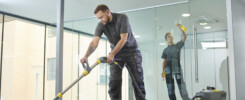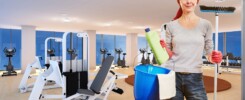In a bustling office environment, maintaining a clean and healthy workspace is crucial for employee productivity, safety, and overall well-being. High-traffic areas are the most vulnerable to dirt, germs, and wear and tear, making it essential to prioritize daily cleaning in these zones. Whether you’re running a small startup or managing a large corporate office, ensuring that these areas remain spotless can have a significant impact on both the office atmosphere and employee morale.
In this blog post, we’ll explore the top five high-traffic areas in your office that need daily cleaning to maintain a hygienic and productive workplace.
1. Entrance and Lobby Area
The entrance and lobby area are the first points of contact for employees, clients, and visitors. These areas experience the highest foot traffic, as people come in and out of the office throughout the day. As a result, they accumulate dirt, dust, and germs quickly.
Why it needs daily cleaning:
- Shoes and bags bring in dirt, salt, moisture, and germs from the outside.
- High-touch areas such as door handles, elevators, and waiting area furniture can harbor harmful bacteria.
- A clean and welcoming entrance helps create a positive first impression for visitors and clients.
Cleaning Tips:
- Sweep or vacuum the entrance area at least once a day to prevent dirt buildup.
- Wipe down door handles, light switches, and any touchpoints regularly with disinfectant wipes.
- Clean and sanitize the lobby seating and tables to avoid the spread of germs.
2. Kitchen and Breakroom
The kitchen or breakroom is another high-traffic area that needs attention daily. Employees often gather in this space to eat, drink, or take a quick break. As a shared space, it’s susceptible to spills, crumbs, and the accumulation of food waste.
Why it needs daily cleaning:
- Food remnants can attract pests and create unpleasant odors.
- Shared appliances, like microwaves, refrigerators, and coffee machines, can become breeding grounds for bacteria if not cleaned daily.
- High-touch surfaces, such as countertops, faucets, and sink handles, need disinfecting to prevent the spread of germs.
Cleaning Tips:
- Wipe down countertops, sinks, and tables after every use to remove crumbs and spills.
- Clean and sanitize kitchen appliances, such as microwaves and coffee machines, to ensure cleanliness and hygiene.
- Empty trash bins daily and sanitize them regularly to prevent odors and pests.
3. Restrooms
Restrooms are one of the most critical areas to clean daily, as they can harbor harmful bacteria and viruses that spread easily among employees. High-traffic restrooms can become dirty quickly, especially if multiple people are using the facilities throughout the day.
Why it needs daily cleaning:
- Restrooms are high-traffic zones where people frequently touch common surfaces like faucets, doorknobs, and toilets.
- Bacteria, germs, and viruses can linger on surfaces if not disinfected regularly.
- A clean restroom is essential for creating a comfortable and hygienic environment for employees.
Cleaning Tips:
- Clean and disinfect toilets, sinks, and high-touch surfaces such as door handles, faucets, and light switches daily.
- Ensure soap dispensers are full and that paper towels or hand dryers are in working order.
- Mop floors regularly to prevent the buildup of dirt and bacteria.
4. Desks and Workstations
Individual desks and workstations are where employees spend most of their time, making them a prime location for germs, dirt, and clutter. Papers, office supplies, and electronic devices can accumulate dust and debris quickly, which can lead to health problems and decreased productivity.
Why it needs daily cleaning:
- Desks are high-touch areas that collect germs from typing, eating, and handling documents.
- Personal items, such as phones, keyboards, and chairs, can harbor bacteria that spread to other surfaces.
- A cluttered and dirty workspace can hinder focus and efficiency.
Cleaning Tips:
- Encourage employees to wipe down their desks with disinfectant wipes at the end of each day.
- Ensure office equipment like keyboards, phones, and monitors are cleaned regularly to reduce the risk of contamination.
- Organize workstations by decluttering surfaces and removing unnecessary items.
5. Meeting Rooms and Conference Areas
Meeting rooms and conference areas are spaces where employees and clients come together to collaborate and discuss important projects. These areas experience frequent use and can accumulate dust, food crumbs, and smudges on tables, chairs, and presentation equipment.
Why it needs daily cleaning:
- Meeting rooms often have a high turnover rate, with multiple groups using the space throughout the day.
- Chairs, tables, and presentation tools are frequently touched, making them susceptible to germs and dirt.
- A clean meeting room ensures a professional atmosphere and promotes effective collaboration.
Cleaning Tips:
- Wipe down tables, chairs, and presentation boards after every meeting.
- Clean and sanitize any audio-visual equipment, such as microphones, remote controls, and projectors.
- Vacuum carpets and floors regularly to keep the space looking neat and inviting.
Conclusion
Maintaining a clean office environment is essential for the health, safety, and productivity of employees. High-traffic areas like the entrance, kitchen, restrooms, desks, and meeting rooms require special attention and daily cleaning to ensure hygiene and comfort. By focusing on these critical zones, you can create a cleaner, healthier, and more efficient workspace for your team.
Daily cleaning not only enhances the appearance of your office but also helps in reducing the spread of germs and bacteria, leading to fewer sick days and improved morale. Consider partnering with a professional office cleaning service to ensure that these areas are maintained to the highest standard and to free up your staff to focus on their core work tasks.
Remember, a clean office is a happy office!


